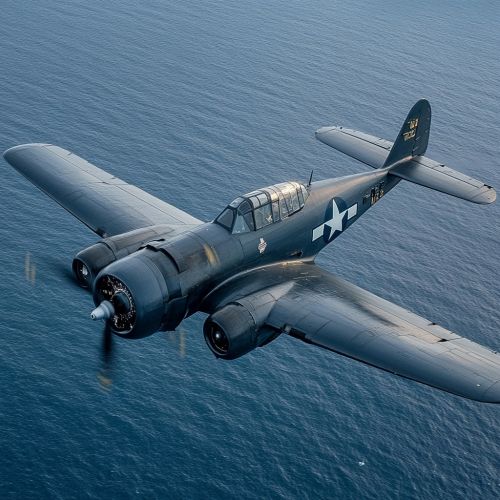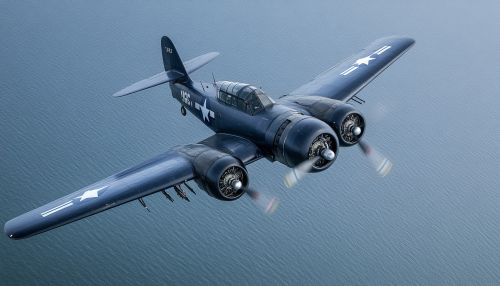Grumman TBF Avenger
Introduction
The Grumman TBF Avenger is a torpedo bomber developed by the American aircraft manufacturer Grumman during World War II. It was one of the most effective and versatile aircraft in the United States Navy's arsenal, known for its durability, payload capacity, and adaptability to various combat roles. The Avenger played a crucial role in the Pacific Theater, contributing significantly to the Allied victory over Japan. This article delves into the technical specifications, operational history, and legacy of the TBF Avenger, providing a comprehensive overview of this iconic aircraft.
Development and Design
The development of the TBF Avenger began in response to a 1939 United States Navy requirement for a new torpedo bomber to replace the obsolete Douglas TBD Devastator. Grumman's design team, led by Leroy Grumman, focused on creating an aircraft that combined robust construction with advanced features for its time. The prototype, designated XTBF-1, made its maiden flight on August 7, 1941.
Airframe and Structure
The Avenger featured a mid-wing monoplane design with a large, spacious fuselage to accommodate a crew of three: pilot, turret gunner, and radioman/bombardier/ventral gunner. The aircraft's construction utilized a combination of aluminum alloy and steel, providing a balance of strength and weight. The wings were equipped with folding mechanisms, allowing for efficient storage on aircraft carriers.
Powerplant
The TBF Avenger was powered by a single Wright R-2600-20 Twin Cyclone radial engine, which produced 1,900 horsepower. This engine provided the Avenger with a maximum speed of approximately 275 miles per hour and a range of 1,000 miles, making it suitable for long-range missions. The engine's reliability and ease of maintenance contributed to the Avenger's reputation for durability.
Armament and Payload
The Avenger's primary armament consisted of a Mark 13 torpedo, which was carried internally within the bomb bay. The aircraft could also be equipped with up to 2,000 pounds of bombs or depth charges for anti-submarine warfare. Defensive armament included a .50 caliber machine gun in a dorsal turret and a .30 caliber machine gun in a ventral position, providing protection against enemy fighters.


Operational History
The TBF Avenger entered service with the United States Navy in 1942, with its first combat action occurring during the Battle of Midway. Despite initial setbacks, the Avenger quickly proved its worth in subsequent engagements, such as the Guadalcanal Campaign and the Solomon Islands Campaign.
Pacific Theater
In the Pacific Theater, the Avenger was instrumental in several key battles, including the Battle of the Philippine Sea and the Battle of Leyte Gulf. Its ability to deliver torpedoes and bombs with precision made it a formidable opponent against Japanese naval forces. The Avenger also excelled in anti-submarine warfare, contributing to the destruction of numerous enemy submarines.
Atlantic and European Theaters
While primarily associated with the Pacific, the Avenger also saw action in the Atlantic and European theaters. It participated in anti-submarine patrols and convoy escort missions, safeguarding Allied shipping from German U-boats. The Royal Navy's Fleet Air Arm operated Avengers under the designation "Tarpon," utilizing them in various operations, including the invasion of Normandy.
Post-War Service
After World War II, the Avenger continued to serve in various capacities, including as a trainer, target tug, and utility aircraft. It was also adapted for civilian use, with some models converted for agricultural and firefighting purposes. The Avenger remained in service with several air forces and navies worldwide until the 1960s.
Variants
Numerous variants of the TBF Avenger were produced, each tailored to specific roles and requirements. The most notable variants include:
TBF-1
The initial production model, featuring the Wright R-2600-8 engine and basic armament configuration. It served as the foundation for subsequent improvements.
TBF-1C
An upgraded version with increased fuel capacity and enhanced armament, including additional machine guns in the wings. This variant became the standard production model during the war.
TBM Series
Manufactured by General Motors' Eastern Aircraft Division under the designation TBM, these variants included the TBM-1, TBM-3, and TBM-3E. The TBM-3E featured improved avionics and radar systems for enhanced anti-submarine capabilities.
Special Variants
Several specialized variants were developed for specific missions, such as the TBF-1D for night operations and the TBM-3W for airborne early warning. These adaptations demonstrated the Avenger's versatility and adaptability to evolving combat needs.
Legacy and Impact
The Grumman TBF Avenger's legacy is marked by its significant contributions to Allied victory in World War II and its enduring influence on naval aviation. Its design principles and operational success informed the development of subsequent aircraft, shaping the future of carrier-based aviation.
Cultural Significance
The Avenger's role in pivotal battles and its association with notable figures, such as future U.S. President George H. W. Bush, who served as an Avenger pilot, have cemented its place in popular culture. It is frequently featured in films, documentaries, and airshows, symbolizing the bravery and sacrifice of those who served during the war.
Preservation and Restoration
Numerous Avengers have been preserved and restored by museums and private collectors, serving as tangible reminders of the aircraft's historical significance. These restored aircraft participate in airshows and commemorative events, allowing new generations to appreciate the Avenger's engineering and legacy.
